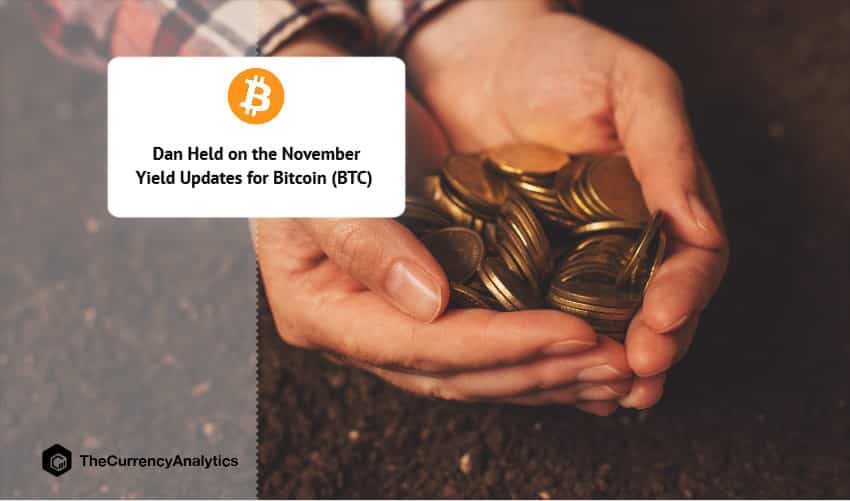
Dan Held: November Bitcoin Yield update: Over the last 2 years, I’ve earned ~2BTC with various yield generating services to earn a historical average of 1-5% on ~25 BTC.
However, many things have changed these last few months. Here’s my journey and how to guide:
Here are the ways you can earn yield: Lending (Easiest/most popular) Yield: 1-5%; Covered calls (Harder/complicated) Yield: 1-80%.
Earning a yield enables you to stack more sats or reduce the temptation to sell your coin through earning an income. The yield you earn comes with risk.
SEC and Lending: The SEC has stated that they consider a wide variety of lending platforms as violating securities law. Because of this Coinbase shut down its plans for a lending service after.
After talking to a few of the lending platforms in the space, there seems to be a few factors that increase risk of enforcement. If they service consumers vs accredited investors, if they continue to service clients in jurisdictions that have asked them to stop; however, the SEC has little desire to make these platforms go bankrupt. It is unlikely they would shut these platforms down in a rushed manner that would cause massive losses for consumers.
The most at-risk platforms for enforcement seem to be: Celsius, Nexo, and BlockFi.
Other updates: Rates have stabilized around 2%. FTX added. A new service was added that I can’t disclose. What’s really cool is that they only lend my coin to overcollateralized borrowers which dramatically reduces risk.
Where does the yield come from? Most of the borrowing is going to be the GBTC arb trade, shorting, DeFi, or the futures “cash and carry trade.” (for all lending platforms)
Risk assessment: When you lend your coins to Ledn, BlockFi, etc. You have to trust that they’ve evaluated counter party risk properly, which includes: Financials of borrower; Collateral requirements (typically 30-110%); and Trading strategy.
As everyone knows, March, December, and May were insanely volatile months. Here’s how they operated through the volatility: Deposits and withdrawals all processed normally (1-2 business days); “zero losses in the lending book”; All of the products had near 100% uptime.
Note: There may be no benefits to diversification as you do not know the counterparty overlap between lenders (ex: Ledn and BlockFi).
Note: I am not a fan of lending/borrowing services that have a token. There is no reason why you need a token as it introduces regulatory and structural risk: Cred blew up earlier this year; Custody issues with Celsius; NYAG sent notices to Celsius and Nexo. There are other ways to earn interest through lending, which include lending coins to exchange margin pools:
Lending is by far the easiest way for a regular trader to earn yield and at size if you’ve got more coin (ex: call strategies suffer from poor liquidity).
What are “covered calls? It’s an option trade which has the owner of the underlying asset (“covered”) sell their upside above a certain price (“strike”) in exchange for a payment (“premium”)
The more likely that event occurring, the higher the premium (very simplified). So, how does that look with some real numbers? (Pull 11/29 split spread)
2/28 $80k strike = $2,070 premium (21% annualized)
2/28 $100k strike = $1,280 premium (13% annualized)
Annualized is a bit of misnomer -you don’t know what the yield will be the next time you sell calls
Historically I’ve been selling 2-3x current price strikes 2-3 months out and earning an average of 4-6% The quotes above are quite a bit closer to the money. Because of how intense Bitcoin’s bull run has been, I’m not selling any new calls for the time being.
With covered calls you only have exchange custody risk, which is some of the lowest risk you can have. One advantage of covered calls is that if you sell a 1yr+ duration call AND it gets assigned (price > strike) then your premium is taxed as long-term cap gains (in the US).
You can also earn a yield through trust minimized services like CoinJoins, providing lightning channel liquidity, and DLCs. CoinJoins: Yield: ~0.5%
Lightning Pool. Yield: variable/low.
Coinjoins allow for Bitcoiners to obfuscate their coin holdings through mixing them with other Bitcoiners. In order to create a market of individuals willing to mix, there are makers and takers. Makers post availability to mix, takers pay the makers for that convenience.
Lightning Pool: Most simplistically, it is an order book for lightning liquidity (or a channel marketplace) done in a non-custodial manner (note: there is a coordinating server).
DLCs (Discrete Log Contracts): Two parties can bet on a certain outcome based on x/y/z condition being met. For example, what the price of Bitcoin might be tomorrow.
The way it works is that two parties send funds to a multi-sig address. In order to settle the bet, an oracle (a party that pipes in outside data like the price of Bitcoin) signs the contract with a signature that corresponds to the hash of the winning outcome. I was given a sneak peek into the Atomic Finance. What they’re looking to do is create DeFi options trading (specifically covered calls) on top of Bitcoin using DLCs.
Super cool: This is done in a self-custodial manner, so you maintain control over your coins more so than on a centralized options exchange like LedgerX. Basically, you’re making a bet on the price of Bitcoin being above or below a certain price (strike) on a certain date (expiry).
Get the latest Crypto & Blockchain News in your inbox.